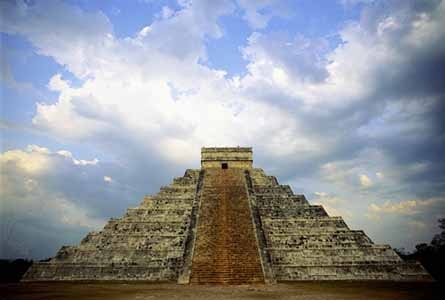Mesoamerican civilization
 the complex of aboriginal cultures that developed in parts of Mexico and Central America prior to Spanish exploration and conquest in the 16th century. In the organization of its kingdoms and empires, the sophistication of its monuments and cities, and the extent and refinement of its intellectual accomplishments, this civilization, along with the comparable Andean civilization (Andean peoples) farther south, constitutes a New World counterpart to those of ancient Egypt, Mesopotamia, and China.
the complex of aboriginal cultures that developed in parts of Mexico and Central America prior to Spanish exploration and conquest in the 16th century. In the organization of its kingdoms and empires, the sophistication of its monuments and cities, and the extent and refinement of its intellectual accomplishments, this civilization, along with the comparable Andean civilization (Andean peoples) farther south, constitutes a New World counterpart to those of ancient Egypt, Mesopotamia, and China.A brief treatment of Mesoamerican civilization follows. For full treatment, see pre-Columbian civilizations.
Archaeologists have dated human presence in Mesoamerica to as early as 21,000 BC. By 11,000 BC, hunting-and-gathering peoples occupied most of the New World south of the glacial ice cap covering northern North America. The cooler climate of this period as compared with that of today supported a grassland vegetation, especially in the highland valleys, that was ideal for large herds of grazing animals. The shift toward sedentary agriculture apparently began after about 7000 BC, when a dramatic global warming caused the glaciers to retreat and tropical forests to overtake the Mesoamerican grasslands.
 The gradual domestication of successful food plants—most notably a mutant corn (maize) with husks—over succeeding millennia gave rise to more or less permanent village farming life by about 1500 BC. In addition to corn, crops included beans, squashes, chili peppers, and cotton. As agricultural productivity improved, the rudiments of civilization emerged during the period designated by archaeologists as the Early Formative (1500–900 BC). Pottery, which had appeared in some areas of the region as early as 2300 BC, perhaps introduced from Andean cultures to the south, took on varied and sophisticated forms. The idea of the temple-pyramid seems to have taken root during this period.
The gradual domestication of successful food plants—most notably a mutant corn (maize) with husks—over succeeding millennia gave rise to more or less permanent village farming life by about 1500 BC. In addition to corn, crops included beans, squashes, chili peppers, and cotton. As agricultural productivity improved, the rudiments of civilization emerged during the period designated by archaeologists as the Early Formative (1500–900 BC). Pottery, which had appeared in some areas of the region as early as 2300 BC, perhaps introduced from Andean cultures to the south, took on varied and sophisticated forms. The idea of the temple-pyramid seems to have taken root during this period.Corn cultivation in one area—the humid and fertile lowlands of southern Veracruz and Tabasco, in Mexico—was sufficiently productive to permit a major diversion of human energy into other activities, such as the arts and commerce. Struggles for control of this rich but limited farmland resulted in a dominant landowning class that shaped the first great Mesoamerican civilization, the Olmec.
San Lorenzo, the oldest known Olmec centre, dates to about 1150 BC, a time when the rest of Mesoamerica was at best on a Neolithic level. The site is most noted for its extraordinary stone monuments, especially the “colossal heads” measuring up to 9 feet (nearly 3 metres) in height and possibly representing players in a sacred rubber-ball game.
The period known as the Middle Formative (900–300 BC), during which the La Venta urban complex rose and flourished, was one of increased cultural regionalism. The Zapotec people, for example, attained a high level of development at Monte Albán, producing the first writing and written calendar in Mesoamerica. However, at this site, as well as in the Valley of Mexico, the Olmec presence can be widely detected.
In the subsequent Late Formative and Classic periods, lasting until about AD 700–900, the well-known Maya, Zapotec, Totonac, and Teotihuacán civilizations developed distinctive variations on their shared Olmec heritage. The Maya, for example, brought astronomy, mathematics, calendar making, and hieroglyphic writing, as well as monumental architecture, to their highest expression in the New World. At the same time, Teotihuacán, in the Valley of Mexico, became the capital of a political and commercial empire encompassing much of Mesoamerica.
Teotihuacán power diminished after about 600, and for the next several centuries numerous states vied for supremacy. The Toltecs of Tula, in central Mexico, prevailed from about 900 to 1200 (the Early Postclassic Period). Following Toltec decline, a further period of unrest in the Late Postclassic Period lasted until 1428, when the Aztec defeated the rival city of Azcapotzalco and became the dominant force in central Mexico. This last native Mesoamerican empire fell to the Spaniards, led by Hernán Cortés (or Cortéz), in 1521.
- Maha Bodhi Society
- Mahadeo Hills
- Mahadev Govind Ranade
- Mahajanga
- Mahakam River
- mahakavya
- Mahalapye
- Mahalia Jackson
- Mahal, Taj
- Maha Maya
- Mahanadi River
- Mahan, Alfred Thayer
- Mahananda River
- Mahan, Larry E.
- Mahar
- maharaja
- Maharaja Jam Sahib of Nawānagar, Sir Ranjitsinhji Vibhaji
- Maharishi Mahesh Yogi
- Maha Sarakham
- mahasiddha
- Mahathir bin Mohamad
- Mahavihara
- Mahavira
- Mahaweli Ganga
- Mahayana